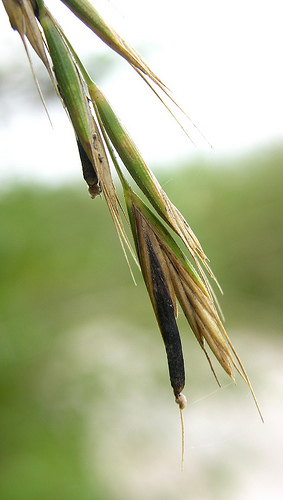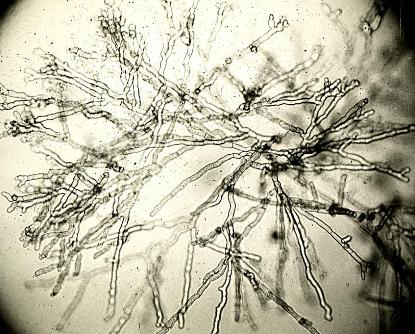The Quest for Food (Nutrition)
HOW DOES CLAVICEPS PURPUREA GET ITS NUTRITION?
Ergot, as we know, is a fungus and cannot produce its own food.
This means that it is not photosynthetic like plants, but it is
heterotrophic. Animals are also heterotrophic, but fungi are
heterotrophic in a different way because they acquire their
nutrition by exoenzymes. Exoenzymes are released at the ends of
the hyphae
 and used to digest the material outside of the
organism before it is ingested. Ergot releases exoenzymes that
are used to break down the components that make up the cell wall
of the plants that it is infecting. For example, it uses Ca2+
ions to break down the pectin as well as other components to
break down the lignin and cellulose. After it does this, we see
the coolest part of the parasitic nature of this fungus. As
you know, ergot is a parasite, but more specifically, it is a biotrophic
parasite, which means that it doesn't kill its host.
Claviceps
purpurea keeps its host alive and then taps into its vascular
system. The vascular system in plants distributes the water and
nutrients throughout the organism. By tapping into the vascular
system of the plant, ergot ensures that it has a constant
nutrition supply and never has to overcome any problems when it
comes to obtaining food. That is one smart fungus!
and used to digest the material outside of the
organism before it is ingested. Ergot releases exoenzymes that
are used to break down the components that make up the cell wall
of the plants that it is infecting. For example, it uses Ca2+
ions to break down the pectin as well as other components to
break down the lignin and cellulose. After it does this, we see
the coolest part of the parasitic nature of this fungus. As
you know, ergot is a parasite, but more specifically, it is a biotrophic
parasite, which means that it doesn't kill its host.
Claviceps
purpurea keeps its host alive and then taps into its vascular
system. The vascular system in plants distributes the water and
nutrients throughout the organism. By tapping into the vascular
system of the plant, ergot ensures that it has a constant
nutrition supply and never has to overcome any problems when it
comes to obtaining food. That is one smart fungus!
WHO ARE THE HOSTS FOR CLAVICEPS PURPUREA?
Hosts for this organism are all open pollinating plants. Members of
the families Secale, Pooidea, Poaceae,
Juncaceae are commonly parasitized. Some common organisms
that serve as hosts for this organism include rye,
barley and wheat but it does NOT infect
corn. The point
to remember is that it always infects open-pollinated plants.
HOW DOES ERGOT TRANSPORT ITS NUTRIENTS ONCE
THEY'RE INGESTED?
Good question! The cool thing about fungi is that there really are
no definitive "cells" within the organism. What I mean by that is
that nothing is compartmentalized. Nuclei and other organelles are
free to move throughout the entire organism because the only
separation between the cells are called the septa, which are like
cells walls but they have a hole in the middle that allows for the
nutrients and everything else to move throughout the organism. They
move everything by cytoplasmic streaming. Like animals, fungi store their food
as glycogen.
compartmentalized. Nuclei and other organelles are
free to move throughout the entire organism because the only
separation between the cells are called the septa, which are like
cells walls but they have a hole in the middle that allows for the
nutrients and everything else to move throughout the organism. They
move everything by cytoplasmic streaming. Like animals, fungi store their food
as glycogen.
If you thought that was cool, make sure to check out the CLASSIFICATION page to learn even more! Or go back HOME.